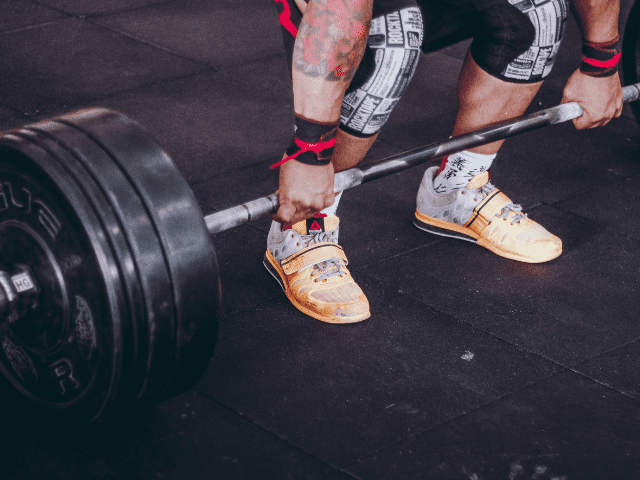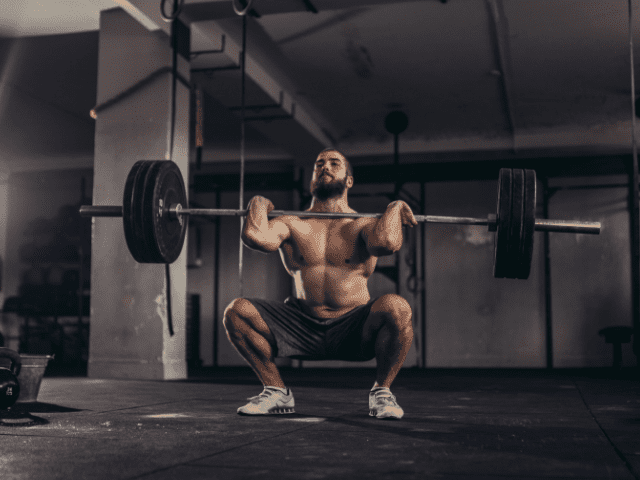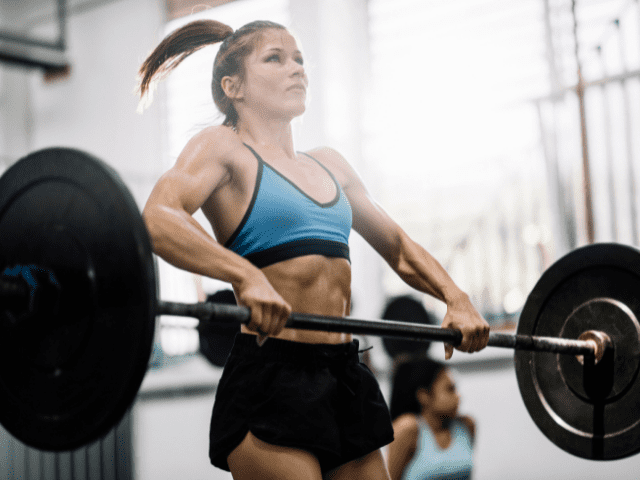Power Clean vs Hang Clean vs Clean (What’s the Difference)
There seems to be a lot of confusion between the differences of the power clean, hang clean and the full clean.
I hear lifts being called the wrong thing all the time and so I’m going to try to help clear up the confusion on power clean vs hang clean vs clean.
The difference between the three lifts is based on the starting position and finish position. Clean & Power Clean start from the floor. Hang Clean starts mid-thigh. Clean and Hang Clean are caught in a full front squat, power clean is caught in a quarter squat.
If you had to read that more than once, don’t worry, I’m going to explain it all in more detail below.
Also, what’s the point of having so many variations (this isn’t even including clean pulls, high pulls or hang power clean) and is it necessary to do all three or is one better than the others?
In this article I’ll explain the difference between power clean, hang clean and clean including what each variation is best for and which one you should be doing in your training.
Power Clean

A power clean is a clean variation where the lifter starts with the bar on the floor, but instead of catching in a full squat, the lifter pulls the bar higher and finishes in a quarter squat position.
Power cleans are extremely popular with strength and conditioning coaches and athletes because you get the benefit of being able to develop force without having to catch in a front squat.
This makes the power clean technique much more forgiving than the clean (and hang cleans).
Lifters with poor wrist flexibility who may really struggle with the front rack position, lifters with tight mid or upper backs who struggle with a full depth front squat or lifters with tight hips or Achilles will all find power clean much easier.
This isn’t to say those issues in mobility or flexibility should be ignored. Not at all. But, the power clean allows the athlete to still work on force development while they continue to improve their range of motion.
Now let’s address the difference between power clean and hang clean by examining what a hang clean is.
Hang Clean
A hang clean is a clean that still includes the full catch, but the start position is different.
Instead of starting from the floor like a clean or power clean, the hang clean start position is at the mid thigh.
The lifter lifts the bar off the floor (or lifting blocks if available) into a standing position, slightly bends the knees and sets the back – then hinges forward, pushing the hips back and bringing the chest forward until the shoulders are directly over or slightly in front of the bar.
It’s essentially starting the clean from about the start of the second pull.
By taking the first pull out of the lift, the hang clean allows the lifter to focus on the aggressive hip extension of the second and third pull and the quick transition under the bar into the front rack position.
Is It Easier to Hang Clean or Power Clean?
Now that we’ve covered what a power clean is and what a hang clean is, which is easier? Is it easier to power clean or hang clean?
If we’re talking about an actual hang clean (and not a hang power clean) that still includes a full squat than I think the power clean is much easier to learn and execute. Here’s why:
Power Cleans allow you to start on the floor, a static position. I can adjust my starting position as much as I need to without worrying about holding the bar while I do it.
In fact, I will have new athletes do just that. We will practice approaching the bar and just work on getting into and holding the starting position. This is much harder to do, although not impossible, with a hang clean.
Combine that with the fact that a true hang clean requires a full catch, I think it makes the power clean a no-brainer in terms of which is easier.
Having said all that I think that any clean (hang, power or otherwise) should be taught in segments so it’s easier for the lifter to learn proper form and not get frustrated.
For instance, I like to teach a lifter a deadlift and a front squat before moving on to a power clean. This allows the lifter to learn body positions and movement patterns before we speed the tempo up with a power clean.
For these reasons I think power cleans are easier to learn than hang cleans, although I think both can picked up rather quickly with practice and good coaching.
Clean

The clean is the complete movement, start position from the floor, catching in the bottom of a full front squat and then standing tall. It’s the first half of a full Clean & Jerk that you see in Olympic weightlifting.
This is the most technically demanding movement compared to the power clean and hang clean simply because it involves the most moving parts.
The lifter needs to not only be strong, but know when and how to apply their power and also be coordinated and athletic enough to explosively extend and then quickly shift their body position to receive the weight.
Just like I would progress a lifter from a deadlift and front squat before introducing the power clean, I also wouldn’t start with a full clean being a lifter’s first Olympic lifting movement.
Start with either the power clean or hang clean and then continue to add more components of the full lift as you become more proficient.
Other Clean Variations
I briefly mentioned at the beginning of this article that clean, power clean and hang clean aren’t even all the clean variations. There’s actually quite a few more. Just like with all variations, the only difference is either the start position or the finish position.
Let’s take a look at a couple of the other most common variations.
Hang Power Clean
If the hang clean means you start in a hang position rather than the floor and a power clean means you catch in a quarter squat instead of a full catch, what do you think a hang power clean entails?
If you guessed a clean that starts in a hang position and then finishes with a quarter squat catch, you get a gold star!
The hang power clean is another version of the clean that is quite popular with athletes because it takes a lot of technical pieces out of the lift and allows the athlete to focus on force production. It’s also the version that I was first introduced to Olympic lifting with when I was in high school.
It’s still critical to work on having good form though, because too often I’ve seen the hang power clean turn into a massive reverse curl with the athlete using their full body to try to move the weight any way possible.
This is extremely dangerous and if it’s being allowed by a coach, flat out reckless.
Lower the weight if needed and focus on being explosive with good technique. It’s the only way to most importantly stay safe, but to also see the power development transfer to the field or court.
High Hang Power Clean

As you might expect, this variation is very similar to the hang power clean but instead of starting with the bar mid-thigh, the bar starts closer to the hip in the power position.
The lifter will have an almost completely vertical torso, with a slight bend in the hips, knees and ankles.
This variation focuses solely on the third pull and that final ‘hip pop’ of the movement, driving the hips forward along with the shrug, high pull followed by the catch.
Because their isn’t a lot of extension left to generate power, you won’t be able to use nearly as much weight, but the high hang power clean does isolate this portion of the lift allowing the lifter to really focus on technique.
Personally, I like to high hang clean (same starting position but with a full squat catch) with my athletes to start learning how to aggressively pull themselves under the bar and catch in that full squat position.
Squat Clean?
The “squat clean” is not a real lift and should never be uttered by any person, ever. This is a hill that I am willing to die on.
Which Variation is Best?
Unless you plan on competing in Olympic weightlifting (in which case clean would obviously be the best), I don’t see any variation as being inherently ‘better’ than the others.
All Olympic lifts incorporate maximum power output and are the epitome of a full body exercise. Not only is almost every muscle being worked, but the upper body and lower body have to be in sync. There are very few things in a weight room that can do this.
I will actually use each one at different times throughout the year over the course of a full off-season.
If I want to take a little extra stress off the posterior chain, I may go with a lighter hang clean vs a power clean. Often times I’ll even have the athletes start off blocks – another variation that we haven’t even discussed.
If I want to focus on a particular aspect of the clean that I feel we need to work on then I’ll choose the variation that allows us to do that. For example, if our front rack position is struggling than we may do high hang power clean for a few weeks to help improve that technique.
Sometimes I just like to switch up variations for the sake of switching things up. It gives the athletes a new challenge and keeps the workouts from getting boring.
Final Thoughts
Hopefully after reading through this article you now have a better understanding of the differences between power clean, hang clean and the full clean.
The final thought I want to leave you with is to make sure that you are using proper power clean technique. As amazing as I think the power clean is, if done with incorrect form it can lead to a serious injury.
Now, if you need a lifting program that incorporates the power clean in it (because most of my programs do) check out all my currently available strength and conditioning programs.

